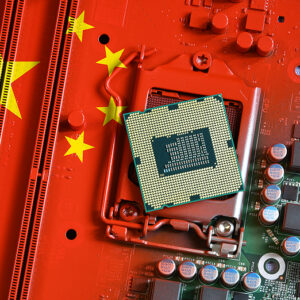American politics may be harshly divided along unbendable partisan lines, but one topic brings the two parties together: China.
President Biden’s director of national intelligence, Avril Haines, said China “represents both the leading and most consequential threat to U.S. national security and leadership globally.”
Former president Donald Trump’s national security Adviser John Bolton called China “the existential threat in the 21st century.”
China watchers are now raising the alarm about China’s ability to evade Western sanctions on technology, particularly microchips, and increase its ability to threaten the United States.
National security experts are sounding the alarm about open-source tech, which is rapidly becoming a workaround to sanctions against China’s advanced technology sector. With chips — which are used to power cell phones, automobiles, drones and advanced military tech — the stakes couldn’t be higher.
A computer chip with a history dating to the early 1980s could revolutionize the technological sector. The RISC-V (pronounced “risk five”) is open-source standard technology that “allows anyone to freely develop their own hardware” to run software. Instead of using proven, vetted technology that is not prone to manipulation but is subject to U.S. export controls — such as those developed by Intel, AMD or Arm — open-source technology can be used by anyone, anywhere, with the know-how to do so, opening up a world of potential security risks.
Rick Switzer, a director in the State Department’s Special Envoy for Technology office, warned the next pandemic could involve chips made in China. “The attacks were traced to a cloud service provider for regional banking firms, but outages now appear to be more widespread, covering close to 40 percent of all cloud storage services across the country,” he wrote in “Future Scenario 2028” for Special Competitive Studies Project.
“Government investigators finally discover the issue: a hardware-based on-off switch embedded in a series of voltage-regulating chips. The attackers flipped billions of these switches simultaneously, preventing logic chips from connecting to the storage chips in cloud servers.”
Switzer’s worry is focused on the RISC-V chip model.
Almost six dozen Chinese companies, including companies the U.S. government has placed on the restricted entity list, are involved in the RISC-V alliance.
Chinese chip design firms switched to the technology because of its accessibility and the Chinese government’s push to do so. That includes tech giant Alibaba, which released two RISC-V-based processors. So far, it appears China remains behind the curve on RISC-V. Alibaba’s RISC-V processor can only run simple processes on Android’s O.S. But if U.S. and Chinese companies are allowed to continue sitting side by side in the development of that technology, that soon will change.
“We’re on track to have 62.4 billion RISC-V cores by 2025,” said Calista Redmond, RISC-V International CEO, in 2020. “The market for RISC-V IP and software is expected to grow to over a billion dollars by 2025.”
Not everyone sees that as good news.
“China’s pivot towards open-source chip design demonstrates how difficult it is to implement restrictions on any single type of technology,” said Elaine Dezenski, senior director and dead of the Foundation for Defense of Democracy’s Center of Economic and Financial Power. “On the other hand, export controls, sanctions and related restrictions have tremendous near-term value in protecting U.S. leadership and constraining malign uses of American technology. But the toolkit of U.S. economic statecraft must remain as flexible and nimble as those inevitable attempts to circumvent it.”
Tech commentators believe American corporations will simply follow the profits.
“American companies do business with China for many reasons, but a lot of the time it comes down to money,” said Amy Chang, resident senior fellow in Cybersecurity and Emerging Threats at the R Street Institute on China’s allure to U.S. companies. “Labor and logistics and taxes are cheaper than doing business elsewhere, and because there is a large swath of relatively wealthy middle and upper class in China as prospective consumers.”
Ryan Nabil, director of technology policy at the National Taxpayers Union Foundation, said the interdependence of the American and Chinese economies means more business for everyone.
“Bilateral trade relations continue to be driven largely by the market forces at play in each economy,” Nabil said. “Top U.S. exports to the PRC include soybeans, civilian aircraft, automobiles, corn and coal. Conversely, top imported products from China include machinery and mechanical appliances, furniture, toys and other miscellaneous manufactured items.”
There is disagreement on what the United States can and should do regarding RISC-V and China. Switzer suggested a national security review of open-source hardware in critical infrastructure, import restrictions, and more domestic investment. Nabil wants more transparency and disclosure requirements before determining risks.
He said, “Clearer and evidence-based security standards could be helpful” regarding device security. Nabil added that open-source technology is overall positive because it “makes it easier for more firms, including U.S. and European companies, to enter the global semiconductor markets.”
RISC-V International did not comment on whether there was concern the U.S. government might take steps to make RISC-V adoption harder for companies.
Please follow DVJournal on social media: Twitter@DVJournal or Facebook.com/DelawareValleyJournal

